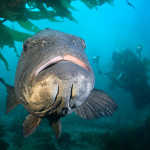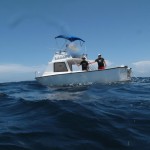 When Andrea Marshall began studying the manta rays of Mozambique for her dissertation five years ago, she never expected to discover a new species, let alone a globally cosmopolitan, highly migratory ocean wanderer. She was “awestruck by their beauty,” studied the rays, and then gradually noticed subtle differences between them. Species can be cryptic; hard to recognize from others. Individuals are identified by their unique patterns of marking on the body and underside.
When Andrea Marshall began studying the manta rays of Mozambique for her dissertation five years ago, she never expected to discover a new species, let alone a globally cosmopolitan, highly migratory ocean wanderer. She was “awestruck by their beauty,” studied the rays, and then gradually noticed subtle differences between them. Species can be cryptic; hard to recognize from others. Individuals are identified by their unique patterns of marking on the body and underside.
The clue to Marshall’s discovery was lifestyle.
“The two species have mainly overlapping distributions, but their lifestyles differ greatly; one is migratory and the other is resident to particular areas along the coast. Other differences between the two species lie in their colour, skin texture, reproductive biology, and the presence of a non-functioning type of sting on the tail of one of the species.”
One species is Manta birostris, the black manta. The other is apparently unidentified. The Telegraph UK reports the story here.
This research highlights the need for international management of highly migratory species, and the fact there is a global fishery for manta rays. But what makes this story great to me is not what Andrea Marshall and her colleagues discovered, its how they roll.
New species are discovered all the time. Americans have a similar situation with the Orcas in Puget Sound. Some are migratory and some are resident. The most impressive aspect here is the collaborators’ multifaceted approach to science communication. They made a movie, they made posters, they prepared their websites for the announcement, and then released their findings. This is the future of scientific communication. Every scientist wants to do be able to do this, but really, it takes a village.
This manta ray research in Mozambique takes a holistic, nearly ideal approach to science and community-based conservation. The press release doesn’t focus on that. Andrea Marshall works with the community in Mozambique. They have a fishery for manta rays. She established a research foundation with a partner Simon Pierce. They downplay the fishery aspect, but they coordinate with IUCN for the global assessment of fisheries and elasmobranchs. It’s like Science 2.0. They seem to embrace every aspect of community.
To round it out, they partner with an NGO, the Save our Seas Foundation to raise global awareness about the issue. They make a BEAUTIFUL video trailer to accompany the story. Then, Marshall announces her results at the American Elasmobranch Symposium in Canada, and tags on the press release. This is a multimedia presentation model for broadcasting scientific results.
The only question we’re left asking is “where’s the paper?” It’s almost a cliffhanger ending. I can’t wait to tune in to the next episode. Congratulations Andrea Marshall.






This is indeed a fantastic finding! Congrats to Marshall for all her work on this. Too often us pelagic folks think that cryptic species are only for things like parrotfishes or bonefishes, but that’s not at all the case — one prominent example recently was the work by one of my NSU colleages, Dr. Mahmood Shivji*, who used molecular genetics and morphometrics to demonstrate the semi-cryptic roundscale spearfish mixed in with all the white marlin catches in the North Atlantic. That’s not likely the last case of this either, as there’s recently been revision** within even the phylogenetics of the billfishes as a whole.
More importantly, lots of lesser-known species may also exhibit slight, but fundamentally important, differences within what are still considered “cosmopolitan” populations, such as the escolar (Lepidocybium flavobrunneum) and the lancetfishes (Alepisauridae). While perhaps not as visible as mantas, it serves to point out that even us pelagic folks have a long way to go before we consider our species and/or phylogenetic relationships set in stone.
* Shivji, M.S, J.E. Magnussen, L.R.Beerkircher, G. Hinteregger, D.W. Lee, J.E. Serafy and E.D. Prince. 2006. Validity, identification and distribution of the roundscale spearfish, Tetrapturus georgii (Teleostei: Istiophoridae): morphological and molecular evidence. Bulletin of Marine Science. 79: 483-491.
** Collette, B.B., J.R. McDowell, and J.E. Graves. 2006. Phylogeny of Recent billfishes (Xiphioidei). Bulletin of Marine Science. 79: 455-468.
Awesome input. Thanks, Dave. There is definitely a great picture here. Deserves a special post, or a Billfish Weekend, even. Forward anytime!
Sorry, … ” a greater picture here”, a bigger picture.
I know how she feels. The first time I saw a manta it was love at first sight1 I couldn’t believe the size and grace of the creature and the way it’s colouring camouflaged it at only a relatively small distance away. Now it was here, now it was gone – there was an eery, ghostly quality about the way it could disappear and reappear. I’m very envious of Andrea and wish her all the best for her research.
No worries, Peter. One final note: the annual meeting of the American Elasmobranch Society (AES) is going on right now in Montreal — one that has a special symposium this year on the Mobulid rays (devils and mantas). I imagine that her work will find its way out into the peer-reviewed world shortly.
Um, isn’t the other Manta marshalli or some such? Or is that pending publication of the paper.
Names are never valid until published, conforming to the rules of ICZN.
Also, by convention, its not appropriate to name a new species after oneself.
According to the press release, there are other names out there for mantas, including Manta raya, M. ehrenbergii, and a variant called “Beebe’s manta”. It’s not clear if the new species is one of those or not.
…one prominent example recently…
See, this to me is the biggest argument for Open Access. I’ve heard about this roundscale spearfish business (from the fishing side, not the research side) and would love to read the paper, but my institutional access doesn’t cover it! Admittedly your colleague is unlikely to get any citations from me anyway, but readership would be nice, no?
I’d never pass up Nature or Science over Open Access ideology, but for pragmatic reasons I always favor accessible journals over comparable inaccessible ones. (Or is Bulletin of Marine Science the equivalent of Cell for fish?)
JSinger, to me readership is just as nice as citations! It relates to the broader impacts of research. In fact, publishing websites do keep track of downloads and page views of new articles. Several even have a sidebar listing to top 5 downloads or viewed. So the publishing companies are very interested in readership as well. Anything that might generate publicity is good for the journal, good for the authors and good for the authors’ institutions.
I don’t think BMS is a top journal for fish. Its 2005 IF (even though I disagree with IF…) is 0.8. Limnology and Oceanography is 3.2, Marine Ecology Progress Series is 2.3, Fisheries is 2.1, Canadian Journal of Fisheries an Aquatic Sciences is 2.0, Marine Biology is 1.8, Aquatic Sciences is 1.7 etc. etc. etc.
In fact small, in house journals like BMS are hurt tremendously by closed access policies for reasons you have outlined. If no one but a few can get the journal it will never get publicity and its papers will be read less. I made this mistake my first publication, submitting to a small in house museum journal.
Good points. There is another aspect to consider, though. Some in house journals have a long history for certain taxa. For example, Proceedings of the Biological Society of Washington (PBSW) and Zootaxa (open access) are journals of record for the gorgonacea. Zootaxa stopped doing single species descriptions one year ago because they were flooded with submissions. They’ve been around 7 years and already they change the rules. So, in my opinion, PBSW is the place to be for single species descriptions of gorgonacea. Species described there become part of that legacy.
Peter, that is exactly why my shrimp will be published in PBSW. But I am not happy with that the whole publishing experience there. I think its time for them to reinvent themselves somehow.
Yes, I’ve spoken to others who feel the same way. But I wouldn’t call PBSW a small in house museum journal, isn’t it the Smithsonian NMNH journal of record?
The Smithsonian has suffered budget cuts and administrative chaos recently, but there is so much history and talent behind those walls that could be revealed. For example, did you know Nabokov, the author of Lolita, worked for a while on butterflies at NMNH?
Part of what they need is you and me in there, Kevin, so we can help them build their bridge to the future. Where do we sign?
Some in house journals have a long history for certain taxa.
After seeing Kevin’s list of impact factors, I’d figured there must be *some* reason for the choice of journal. I know nothing about ichthyology, but it seems like the rediscovery of an old species and its confusion with a high-profile gamefish should be pretty marketable. I’d have gone to Science with it!
Thanks for all of your comments. Dr. Leonard Compagno and some of the top elasmobranch taxonomists are busy helping me work out the appropriate nomenclature for the two, possibly three, species in this genus. Once this has been resolved we will submit to Zootaxa.
We ask for everyone’s patience as Manta has one of the more extensive generic and species synonymies of any living genus of cartilaginous fish. The genus Manta has 10 generic and 25 species synonyms, mostly without type specimens.
Currently I am still referring to the species as A, B, and C.
Andrea, thanks for your comment! Send us the paper here at Deep Sea news and we’ll post on it.
Congratulations, Andrea, for such a great research. As others have mentioned above, the more closely we look at what appear to be cosmopolitan species, chances are that there are species complexes, with perhaps one species widely distributed and several cryptic ones with more restricted ranges (in general, I am not talking about mantas).
Regarding publication in Zootaxa and open access, if you can come up with money to pay for open access, it should be a good investment, because many more people would have access to your paper. And Zootaxa has ones of the lowest charges for open access that I know, so it is definitely worthy it. I like Zootaxa and highly recommend it, but you probably should also consider Science or Nature, since your research should be of interest to a wide readership.
Good luck with your cool research.
*PS – Kevin – I don’t think Zootaxa would let you post a paper published in their journal here at DPS, unless the author pays for open access (even then you should make sure they allow). But you could post links to the article.
Good luck, Andrea. It kind of makes sense there are so few type specimens, since so many 19th century naturalists would rather paint a new species than capture and describe one. ;)
If you’re working with a fishery, you probably have more data than they ever did.
Ocean Revolution contacted DSN today with more pictures and details of the community work you’re doing together. We’ll post more about this in coming weeks.
Fascinating blog……we can acquire lots of essential things especially in scuba diving and I really love the photo shots under the sea…